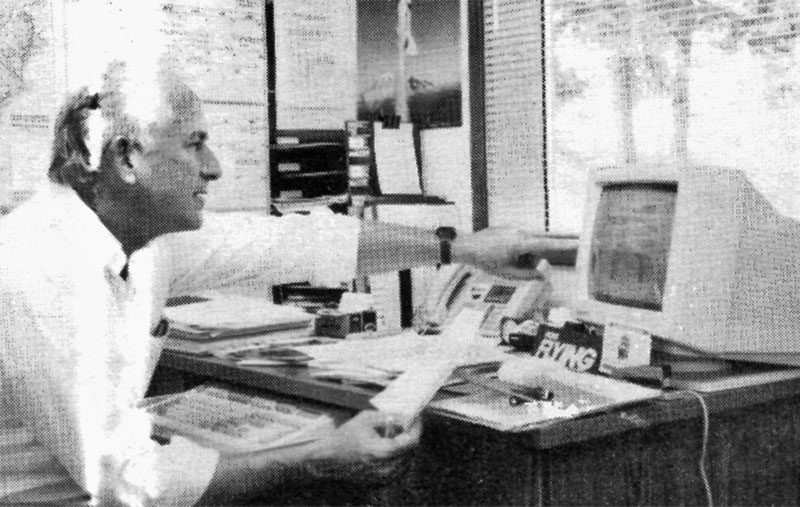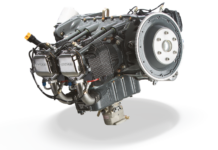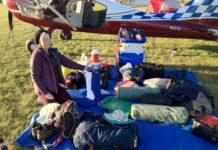“You try to do too many things when we go someplace,” is a comment I’ll sometimes hear from my wife, Bonita. And I guess it’s true. When two air-shows on back-to- back weekends occurred in Southern California recently, I jumped at the chance to visit family and friends in San Francisco, San Diego, Los Angeles, Palm Springs and Phoenix. You see, the Los Angeles area is where I grew up, first worked as an A & P mechanic and learned to fly. Now, with this opportunity and motive, (sounds a little like a detective story), I determined to make the most of it. Besides this is where the speed and reliability of the Glasair in really shines.

THURSDAY, October 18: 1 scheduled the mid-morning departure from our factory in Arlington, Washington for an afternoon appointment at U.S. Propeller Service in Stockton, California. Dennis Huntington, who is finishing his own Glasair III at our Service Center here in Arlington, heard of my trip and requested a ride to his home in Davis near Sacramento. “Great,” was my response. This way I’ll file IFR (even though we had great VFR weather) and Dennis can pilot from the left seat while I work the radios from the right. (Note: Flying from either the left or right seat in the III makes little difference to me, since so many hours are spent in the right seat giving introductory flights.) The further South we flew, the harder the tailwind pushed. Harbinger of things to come, pilots love a good tailwind. Dennis regaled me with stories of Salt Lake City to Central California IFR flights and in three short hours we were in Davis. Dropping off my passenger, I jumped into the sky and in a few minutes slid into Stockton and a rendezvous with “smoothness”.
Some of you may recall that the Lycoming factory overhauled our Glasair Ill’s engine because of bad fuel obtained in Watsonville, California. This was our first cross-country flight following 10 hours of break-in and we were interested in how the dynamic balance was with this different IO- 540 engine.
U.S. Propeller Service is expanding by building a new overhaul facility in Stockton and since I would be coming through, we arranged an appointment. Tom Richardi, their Customer Service Specialist, who really enjoys his work, made me feel welcome and we got right down to business. After installing the accelerometer on the governor pad and a reflective tape on a propeller blade, a quick check was made at various RPMs. The III was reading 1.0 IPS, enough out of balance for substantial vibration. Tom removed the spinner, added weights on the light side of the propeller hub and reinstalled the spinner. Engine runup revealed the imbalance improved to .5 IPS. Next, he repeated the process, only now he moved some of the weights rather than adding more, and runup revealed we were at .25 IPS. One last movement of weights and “bingo”, we were reading .025 IPS. All this accomplished in less than two hours!
U.S. Propeller Service can be reached by telephone at 800-331- 1668. Their Service Manager, Mike Belmont, will be happy to help you find your propeller or solve your overhaul or balance problem.
Leaving Stockton, I headed our III west, skirted the Class B San Francisco airspace and curved into Petaluma. Golden curls flashed in the late October sun, this was grandson time! My two sons, Dave and Tim, were waiting to pick me up. I was sure glad to see them, but this grandfather’s heart has a special void only Jake can fill. At four years old, he enjoyed jumping into the III and taxiing with me to our final transit parking place. That evening we enjoyed an incredible home cooked meal in a Victorian home on Sausalito Bay watching the moon try to outshine the lights of San Francisco. All it takes is a three hour flight from Arlington to San Francisco and I can hug Jake, hold that sleepy boy and hear him whisper, “I love you, Grandpa”. The Glasair III is certainly a dream full-filler.
FRIDAY, October 14: I got a chance to visit (and help a bit) younger son Tim in his new office in San Rafael and then hung out with oldest son David, looking around San Francisco and taking a brief, gusty get acquainted flight in the III around the beach at Point Reyes. The wind promises to blow out of the North again today. Mid- afternoon I depart Petaluma, leaving family but taking more precious memories. I’ll be back…next time with Grandma.
Climbing to the southeast with full fuel and airshow baggage, but with one seat empty, the III goes upward at over 2,000 feet a minute, grabbing chunks of altitude like that giant climbing the bean stalk. Level at 11,500 feet and clear of San Francisco airspace, the panel mounted Apollo GPS soon shows me at 250 knots and gaining groundspeed as I enter the tailwinds environment. The III is moving so fast, “Flight Following” is constantly passing me off to another controller as we speed down the central California fruitful valleys. When a broken stratus layer forces me up to 13,500 feet, tailwinds increase to over 50 knots. Smiling, I remember all those bumpy congested training hours in the Los Angeles basin and now I’m flying an airplane with performance undreamed of, while high enough to “GPS direct” across this complicated airspace. South of Los Angeles, “Center” has released me for a VFR descent. However, my fickle friend, tailwind, encourages me to stay high. Finally, I must come down so trim is rolled in and I increase the airspeed to 280 knots I AS. (With the tailwind, the III is traveling well over 340 knots across the ground). Soon I’m faced with one of the Ill’s delightful dilemmas, lowering power to slow the III to the allowable 250 knot IAS below 10,000 feet. Once again, power must be reduced as I slow for the 200 knot IAS maximum approaching the airport control area. Less than two hours from north of San Francisco to Brown Field, at the Mexico border. Boy, is this Glasair III fast!
SATURDAY and SUNDAY, October 15, 16: Stoddard-Hamilton has come to join the Family Fly-In at San Diego’s outstanding and interesting Experimental Aircraft Association chapter. EAA Chapter 14, which is the largest in the world, is made up of many pioneers and trend setters of the aviation industry, but most importantly, lots of builders. (Remember, over 60 years ago, it was to San Diego that Charles Lindbergh came to have his aircraft built for that first, non-stop, Atlantic Ocean flight.) Larry Rothrock arranges for us to park the Glasair III in their novel, round, and very practical hangar. For two days I enjoyed meeting prospective Glasair and GlaStar builders, updating and sharing experiences with other builders and pilots, and talking about the joy of flying the Glasair III. What a great group of builders. Almost every kit and project imaginable has been or is being built here.
Late Sunday afternoon, Bob Fronius, elder glider pilot and restorer, joins me for the short hop to Gillespie Field and arranges for me to park the III in “Skid Row.” So named for the preponderance of tail wheel aircraft. Monday, he and his friend June Wiberg delighted in showing me around this wonderful airport where so many projects are under construction, being restored or maintained in wonderful condition. When Bob heard that one of the questions potential builders ask is, “How long will composite parts last?”, he showed me 35 year-old parts, undamaged by age, that he had cut from one of the first gliders built in Switzerland with the then new material, composite. He kindly gave me a piece to bring back. Ask me and I’ll be happy to show the part to you. The Glasairs are made of strong, long-lasting materials and parts.
TUESDAY and WEDNESDAY, October 18, 19: A quick trip from Gillespie Field to Long Beach allows me to show the III to a highly experienced helicopter instructor pilot, Jackson Shaw. He comments to his students, “If I can see the stick move in your hand, you’re over-controlling the helicopter.” An overstatement? I don’t know. But he proceeds to adapt as fast as anyone I’ve ever seen to flying the III.
Flying on to Brackett Field in the San Gabriel Valley, I can’t resist the temptation to overfly Glendale and the Verdugo Mountains. Here, as a boy, I first gained my interest in aviation, watching World War II aircraft land and take off at Grand Central Airport. In the late 50s, prior to it’s destruction, I was the last student to solo from this Grand Dame, Hollywood’s premier airport of the20’s and 30’s.
Returning from Glendale via the Rose Bowl and while getting clearance into the Ontario Control space, I’m reminded once again of the Ill’s speed. Ontario gently reminds me that El Monte Airport is at 12 o’clock and do I have clearance through there? At 210 knots I need to be higher to clear their airspace. I never had this delightful problem in my rag-wing Luscombe.
THURSDAY, October 20: While on my way to Palm Springs for the AOPA Convention, I can’t resist one last side-trip. As a boy, our family frequently camped at Big Bear Lake. It took only a few minutes to be at 11,500 feet and overfly this marvelous lake and it’s close mountain, San Gorgonio. From this peak, I contacted Palm Springs Approach and requested VFR into the airport 23 miles away. They requested I report “North of the Freeway, 2500 feet.” More fun… I rolled in the trim and down the slide the III came. The airspeed indicated 250 Knots, the GPS indicated 280 knots groundspeed, 3,000 feet a minute descent and 3 minutes later, there we were. Cleared to the tower, pulling power and slowed up to 120 knots, the landing gear is lowered, flaps are down and cleared for landing. What an impressive airplane the Glasair III is to fly.
A meeting at the Combs hangar introduces all the pilots who are going to “taxi” airplanes along two miles of residential streets, to the Palm Springs Convention Center. Safety is our major concern, however, I’m also thinking about our newly overhauled engine and how well it will cool in this 80 degree plus weather. While waiting for our group to taxi, Harold Williamson, currently building a Glasair II-S RG at Palm Springs, (and knows half of the people there), showed me not only his exciting project but Pond’s wonderful warbirds and Piaggio aircraft. Finally, over 50 aircraft taxied along the police- closed streets, and I enjoyed waving to the crowds. Now here’s another plus for the Glasair. Short, 24 foot wingspan leaves plenty of clearance. Engine temperatures were not a problem.
FRIDAY, SATURDAY and SUNDAY, October 21, 22, 23: Hundreds of airplanes and thousands of AOPA members and friends descend on Palm Springs to see the latest in aircraft and hear of developments across the spectrum of aviation. Many are not builders, but fliers, using their aircraft for business. Most asked question? “How can I buy a Glasair III already built?” They loved the performance and beauty of the Glasair and wanted one just like it. Many were intrigued by our involvement with NASA in the development of the Lightning Protection on our Glasair HI and appreciated our willingness to be on the “cutting edge” of aviation. Brian Costello, Service Manager for Stoddard-Hamilton, came down and was a great help Friday and Saturday while also gaining up-to- date information for the avionics he assists builders with. Sunday, Harold Williamson once again was a tremendous help by handing out Glasair and GlaStar information and answering questions at the III while I assisted a forum for kit builders and also saw the future of instrument panels being discussed by NASA researchers.
Following the close of the show Sunday, the aircraft were taxied by return route to the airport. Since the III was ready to fly, I was able to be in the first wave of a mass of aircraft trying to leave Palm Springs at the same time, shades of Sun-n-Fun and Oshkosh. An interesting departure, (270 degree over the top of the airport) and I was off to Phoenix. Slipping into Falcon Field at Mesa, I was almost done. One last demonstration flight Monday and the Glasair III starts the PIC training program, Wednesday.
PIC’s instructor, Al Adams, informed me that the schedule had been moved up and it would start with the III at 6 AM, Monday morning. Yes, he will have the III back for my prearranged 10 AM flight. “No problem,” I said, “9 airports, 14 takeoffs and landings, 11 days, smooth as silk, ready to go.” What an incredible, beautiful business machine. The Glasair III.



